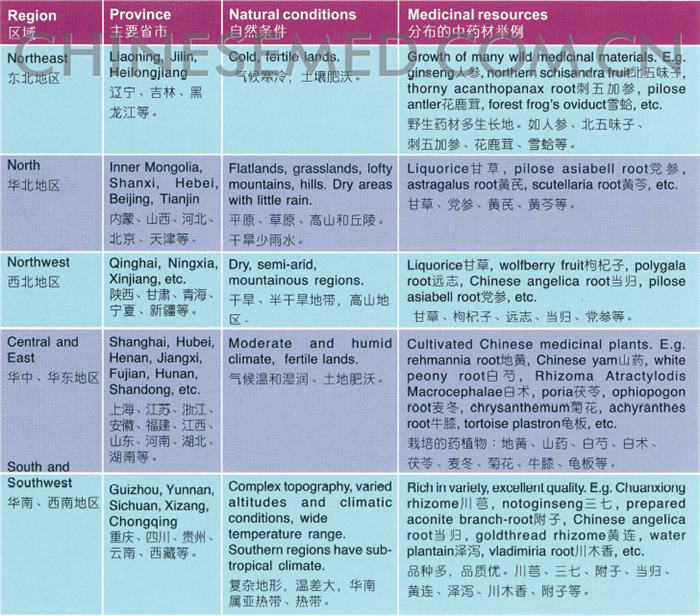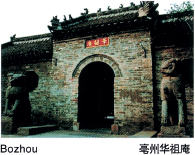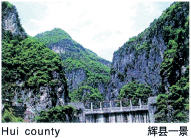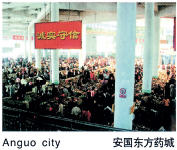China’s vast territory abounds with natural resources. Climatic factors, especially heat and humidity, determine the distribution of various Chinese medicinal resources.

Distribution regions of Chinese medicines

Fast facts
The Four Famous Pharmaceutical Cities of China
Bozhou city  of Anhui, Hui county
of Anhui, Hui county  of Henan, Anguo city
of Henan, Anguo city  of Hebei and Yuzhou city
of Hebei and Yuzhou city  of Henan. (Chengdu’s Lotus Pond is also said to be one of the four largest pharmaceutical cities, and Zhangshu city
of Henan. (Chengdu’s Lotus Pond is also said to be one of the four largest pharmaceutical cities, and Zhangshu city  of Jiangxi is called the “Pharmaceutical City of the South”. Many Singaporean and Malaysian businesses specialising in Chinese pharmaceuticals operate from Jiangxi.)
of Jiangxi is called the “Pharmaceutical City of the South”. Many Singaporean and Malaysian businesses specialising in Chinese pharmaceuticals operate from Jiangxi.)
Bozhou 
A city in eastern Anhui province of China, Bozhou is known as the “Pharmaceutical Capital of China  ”. With 3,700 years of history, the city is the hometown of Hua Tuo
”. With 3,700 years of history, the city is the hometown of Hua Tuo  , the renowned physician of the Han Dynasty. During the Ming and Qing Dynasties, Bozhou was one of the four largest pharmaceutical cities in China, distributing over 2,000 kinds of Chinese herbal medicines. It is “the first city of Chinese crude drugs
, the renowned physician of the Han Dynasty. During the Ming and Qing Dynasties, Bozhou was one of the four largest pharmaceutical cities in China, distributing over 2,000 kinds of Chinese herbal medicines. It is “the first city of Chinese crude drugs  .
.

Hui county 
Situated in central Henan province, Hui county is in a dominant position due to its 600-year history of medicinal materials fairs. It also has a reputation for producing and processing herbs the traditional way. The “Medicinal Materials Fair  which is held here annually has become the country’s largest pharmaceutical distribution centre, and is fast developing into a mega pharmaceutical chain store.
which is held here annually has become the country’s largest pharmaceutical distribution centre, and is fast developing into a mega pharmaceutical chain store.

Anguo 
Located in northern Hebei province, Anguo city was previously known as Qizhou  . It has a Chinese herbal medicine trading history of 1,000 years, with its beginnings in the Northern Song Dynasty reaching its peak during the Ming and Qing Dynasties Qizhou became famous with its “Four Unique Products of Qizhou
. It has a Chinese herbal medicine trading history of 1,000 years, with its beginnings in the Northern Song Dynasty reaching its peak during the Ming and Qing Dynasties Qizhou became famous with its “Four Unique Products of Qizhou  ”, earning a reputation as illustrated in the saying “plants turn into medicines only when they reach Anguo, medicines carry no flavour unless they reach Qizhou”.
”, earning a reputation as illustrated in the saying “plants turn into medicines only when they reach Anguo, medicines carry no flavour unless they reach Qizhou”.

Yuzhou 
A city in central Henan province, Yuzhou is called the “Pharmaceutical City of China  ”. There is a historical saying: “Medicines will not get popular unless they reach Yuzhou; no physicians are excellent without meeting the Master of Medicine.”
”. There is a historical saying: “Medicines will not get popular unless they reach Yuzhou; no physicians are excellent without meeting the Master of Medicine.”
Since the Spring and Autumn Period, and Warring States era, miracle-working physician Bianque  , the Medical Sage Zhang Zhongjing
, the Medical Sage Zhang Zhongjing  , Master of Medicine Sun Simiao
, Master of Medicine Sun Simiao  and many others had all visited Yuzhou to practise medicine, gather herbs and write books to expound their theories. During the Ming Dynasty, Yuzhou became one of the four largest herb distribution centres in China.
and many others had all visited Yuzhou to practise medicine, gather herbs and write books to expound their theories. During the Ming Dynasty, Yuzhou became one of the four largest herb distribution centres in China.

